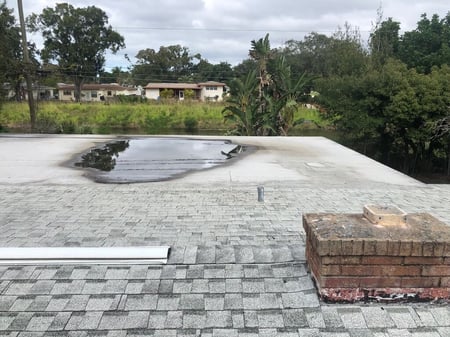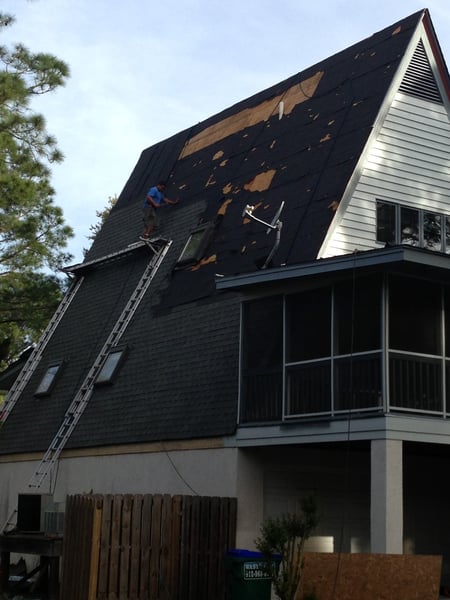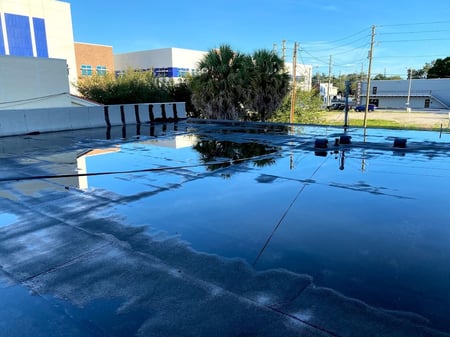
Water ponding on a steep-pitched roof, while uncommon, can pose challenges despite the roof's natural tendency for efficient water drainage. Typically designed to swiftly shed water, a steep-pitched roof's slope aims to prevent water accumulation. However, when water does pool on these roofs, it often indicates underlying issues, be it structural, design-related, or due to environmental factors, that require attention.
At RoofCrafters, we’ve been in the roofing business for nearly 3 decades, and we’ve seen every roofing-related oddity you can imagine, with one of them being water ponding on a steep pitch roof. Naturally, this is distressing to a homeowner, because, well, why is it happening?
That being said, understanding the causes and implications of water ponding on a steep-pitched roof is essential for homeowners seeking to safeguard their roofs from potential damage and maintain their functionality over time. So, to find out why this may be happening to you, read ahead to learn what water ponding is, can it happen to your steep pitch roof, why it might happen to your steep pitch roof, and your next steps. Let’s get started!
What Is Water Ponding on a Roof?

Water ponding on a roof refers to the accumulation of standing water or puddles that remain on the roof surface after rainfall or due to improper drainage. This occurs when the roof doesn't have enough slope or when there are structural issues preventing water from properly draining off the roof.
Ponding water on a roof can be problematic as it can lead to various issues such as:
Leakage: Prolonged standing water can seep through the roof membrane or roofing materials, causing leaks into the building.
Structural damage: The weight of the pooled water can stress the roof structure, potentially causing damage over time.
Deterioration: Standing water can degrade roofing materials, reducing their lifespan and effectiveness.
Mold and mildew: Moisture accumulation provides a breeding ground for mold and mildew, which can affect indoor air quality and pose health risks.
It's essential to address water ponding issues promptly by improving the roof's drainage system, ensuring proper slope, and potentially considering roof repairs or modifications to prevent further water accumulation. Regular roof inspections with a professional can help identify and rectify ponding issues before they cause significant damage.
Can Water Pond on a Steep Pitch Roof?
While water ponding is less common on steep-pitched roofs compared to flat or low-slope roofs, it's not entirely impossible. Steep-pitched roofs are designed to facilitate water drainage more efficiently due to their angle, allowing water to run off more quickly than on flat surfaces. However, several factors can still contribute to water ponding on a steep-pitched roof:

Obstructions: Debris, such as leaves, branches, or other materials, can hinder water flow and create pockets where water accumulates.
Damaged or inadequate drainage: If the roof's drainage system is compromised or insufficient, such as clogged gutters or downspouts, water might pool in certain areas.
Irregularities in roof construction: Minor design flaws, improper installation, or irregularities in the construction of the roof can create areas where water collects.
Ice dams: In colder climates, ice dams can form on steep-pitched roofs, blocking the natural flow of melting snow and leading to water ponding.
While water ponding is less common on steep-pitched roofs, it can still happen, and it's still essential to address any potential issues to prevent long-term damage. Regular maintenance will help you promptly identify any problems that might lead to water accumulation, ensuring your roof functions as intended and avoids structural issues or leaks.
Why Is Water Ponding on a Steep Pitch Roof Uncommon?

Water ponding on a steep-pitched roof is considered abnormal because steep-pitched roofs are designed to encourage water runoff. Their angle allows water to flow down and away from the roof surface more efficiently compared to flat or low-slope roofs.
Here are a few reasons why water ponding on a steep-pitched roof is considered unusual:
Design for drainage: Steep-pitched roofs are intentionally constructed with a significant slope to swiftly direct water away from the roof surface. This design minimizes the chances of water pooling or ponding.
Gravity's effect: The steep angle of the roof allows gravity to swiftly move water down the slope, reducing the likelihood of accumulation.
Water shedding capability: Steep-pitched roofs are typically made with materials and designs that facilitate the shedding of water, preventing it from lingering or collecting on the surface.
When water ponds on a steep-pitched roof, it often indicates an issue with the roof's design, construction, or maintenance. This might involve problems with drainage systems, structural issues, debris accumulation, or other factors hindering the natural flow of water off the roof. Identifying and addressing these issues promptly is crucial to prevent damage to the roof and the building's interior.
How Can I Mitigate Water Ponding on My Steep Pitch Roof?
Mitigating water ponding on a steep-pitched roof involves a combination of preventive measures and regular maintenance. Here are some steps you can take:
.png?width=1200&height=200&name=Recommended%20Reading%20(49).png)
Ensure proper roof design: If you're constructing a new roof, ensure it's designed with appropriate slopes and angles to facilitate water runoff. Proper design is fundamental in preventing ponding.
Inspect and clear debris: Regularly inspect the roof for any debris that might obstruct water flow. Clean gutters, valleys, and any areas where debris tends to accumulate to maintain proper drainage.
Maintain gutters and downspouts: Keep gutters and downspouts free from debris and ensure they're correctly positioned and functioning to direct water away from the roof efficiently.
Address structural issues: Check for any structural settling or damage that might have altered the roof's slope. Rectify these issues to restore the roof's intended pitch for effective water drainage.
Install roof features: Consider installing additional features like roof vents or ridges that can aid in ventilation and improve airflow, reducing the chances of moisture accumulation.
Prevent ice dams: In colder climates, take measures to prevent ice dams by ensuring proper insulation and ventilation in the attic, which can help prevent melting snow from refreezing at the roof's edge and causing ponding.
Professional inspection: Periodically hire a professional roofing contractor to inspect the roof for any issues or signs of ponding. They can provide guidance on necessary repairs or maintenance.
Mitigating Water Ponding: Safeguarding Your Steep Pitched Roof
As you now know, water ponding on a steep-pitched roof is an atypical occurrence due to the design of such roofs, which are intended to facilitate efficient water runoff. When ponding happens, it's often a sign of underlying issues such as poor drainage, structural problems, debris accumulation, or design flaws.
To mitigate water ponding, proactive measures such as regular inspections, debris clearance, maintaining proper drainage systems, addressing structural issues, and preventing ice dams in colder climates are crucial. By promptly identifying and rectifying these issues, homeowners can preserve the integrity of their steep-pitched roofs, preventing potential damage and ensuring optimal functionality.
If you’re currently dealing with water ponding on your steep pitch roof, that could indicate a larger problem with the roof design, and it’s important to promptly sort out the situation. Fear not, because you can easily hit the “Schedule an Inspection” button down below, and one of our experts will examine your roof at your earliest convenience, and find the proper solution as soon as possible!
My name is David Toth and I am the lead estimator in North Florida with RoofCrafters Roofing. Originally from New Brunswick, I have called Florida home for the past 47 years. I enjoy cooking along with traveling to different historical areas in Florida when I have free time.



